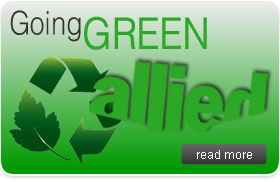Envelope Construction
Allied Printing Resources can manufacture envelopes in almost any number of sizes and shapes. However, almost all envelopes stem from two basic designs; they are either OPEN END or OPEN SIDE. Dozens of different designs can be developed from these two basic styles to meet your particular requirements.
Be sure to contact your Allied representative for further information.
| Open End Center Seam | Open End Single Side |
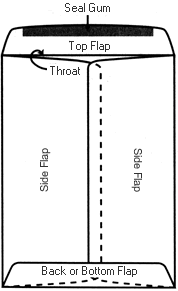 |
 |
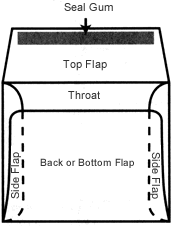 A-Style Announcement
A-Style Announcement
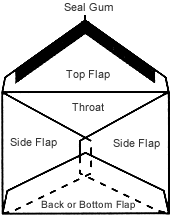 Baronial Style
Baronial Style
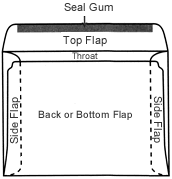 Booklet
Booklet
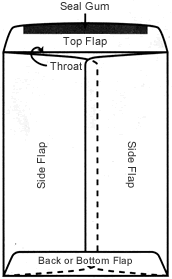 Open End
Open End
This is an Open End (OE) envelope. The opening and the seal flap are located on the short dimension. Open End envelopes are well-suited to hand insertion applications. Larger, Open End envelopes are also called "Catalogs". A 9 x 12" open end has its flap on the 9-inch dimension.
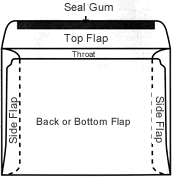 Open Side
Open Side
This is an Open Side (OS) envelope. The opening and the seal flap are located on the long dimension. Open Side envelopes are ideal for automatic insertion, applications and are suited for hand insertion applications and are suited for hand insertions as well. Larger, Open Side envelopes are also "Booklets". A 9"x12" open side has its flap on the 12-inch dimension.
Side Seams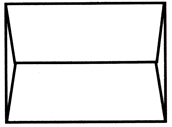
These seams allow for a large, uninterrupted printing area on both front and back of the envelope. Mostly found on booklets, square flap and side seam commercial envelopes. Commercial sizes are suitable for some laser and inserting applications; others should be tested first.
 Single Side Seam
Single Side Seam
Seam is placed parallel to the edge of the envelope. Ussually found in open end style envelopes (with or without flap). The full-sized side flap allows a larger printing area unobstructed by seams or multiple paper thickness. Manual insertion is recommended for this style.
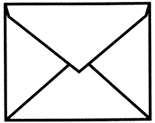 Diagonal Seams
Diagonal Seams
Commonly used in correspondence commercial and pointed flap announcements. This seam style is a workhorse and generally well-suited for applications invloving mechanical insertion equipment, laser printing and postal meters.
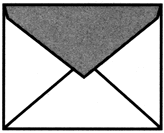 Pointed
Pointed
Elegant, traditional, and more formal. Used primarily on Baronial, greeting card and social stationary envelopes. Not recommended for laser or inserting equipment applications.
 Square
Square
Provides large area for design on flap and has contemporary appearance. May have deckle edge. The lack of a shoulder in this flap can create problems during automatic insertion. Standard No. 10 sizes are suitable for laser printing applications, while other sizes may present difficulties.
 Wallet
Wallet
Similar to a square flap, but with round corners. Satndard flap on most booklet, catalog and specialty commercial envelopes. Flap style enables secure closure of bulky contents and is funtional for automatic inserting, mailing and laser equipment processing.
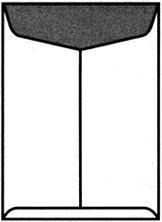 Mail Point
Mail Point
Originally designed to enable volume mailings to run on automatic equipment, the mailpoint flap, normally found on open end (catalog) envelopes, is being replaced by the more modern wallet flap.
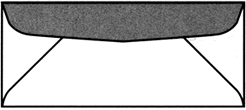 Commercial
Commercial
Standard flap on correspondence-style envelopes for business and commercial use. Quality commercial envelopes have full-cut commercial style flaps. These flaps are designed to reduce make-ready for corner card printing, improve sealing when bulky inserts are used, and enhance inserting and laser printing performance.
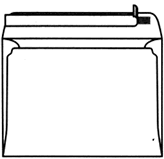 PEEL & SEEL®
PEEL & SEEL®
A release tape liner is applied over a resin adhesive. When the liner is removed and the flap is pressed down, it seals on contact without moisture. Printing after the envelope is folded can be accomplished without interfering with the quality of the seal.
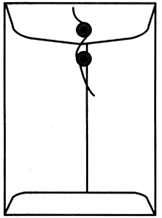 String & Button
String & Button
Tie-down closure for repeated use. Envelopes with this closure treatment cannot be run through graphic and other automated processes after conversion.
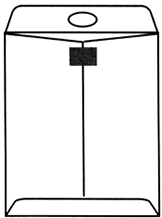 TAC-N-TAC®
TAC-N-TAC®
A Tac-n-Tac seal tape allows reusable sealing flap.
Envelopes can be printed after folding.
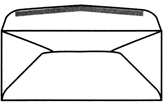 Remoistenable Seal Gum
Remoistenable Seal Gum
Activated by moistening when flap is to be sealed.
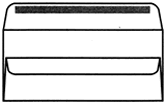 Simple-Seal®
Simple-Seal®
Self-adhering latex adhesive on two surfaces that seal on contact without moisture. The unique folded flap feature on stationary envelopes keeps the two latex flaps separate until sealing is desired.
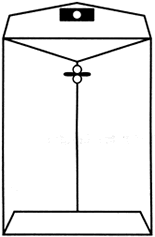 Clasp
Clasp
Double-pronged metal clasp for added security. Envelopes with this closure treatment cannot be run through graphic or other automatic processes after conversion.
 Latex Seal
Latex Seal
Self-adhering latex adhesive on two surfaces that seal on contact without moisture. Flaps are extended and adhesive is exposed. Envelopes with this closure are not recommended for automatic insertion or laser applications.
Envelopes are constructed in many different ways and vary with paper, seams, closures, size and special features. All envelopes are manufactured as a sheet of paper then folded according to the type of envelope produced.
Bangtail - The extra flap on the back panel of the envelope, which is detached at the perforation before the envelope is mailed.
Center Seam - A glued seam that runs up the middle on the back side of the envelope, from the bottom edge up to the throat.
Closure - The way in which an envelope is sealed at the opening.
Commercial - The most commonly used envelope style. It is an open side with diagonal seams. Available as a regular or a window envelope.
Diagonal Seam - Seams that run diagonally across the back of the envelope from the bottom corner to the throat. Used mostly in commercial, announcement, invitation and baronial envelopes.
Gusset - The expandable sides on an expansion envelope.
Inside Tint - Printing on the inside of the envelope that protects against seeing the contents of the envelope.
Open End/Catalog - The opening of the envelope is on the shorter side. An open end will generally have a center seam on the back.
Open Side/Booklet - The opening of the envelope is on the long side. An open side generally has diagonal seams or double side seams.
Inside Seams - A side seam that is glued under the back panel. Inside seams allow the entire back panel to be printed.
Outside Seam - A side seam that is glued on top of the back panel, limiting the printable area on the back panel.
Regular Envelope - An envelope that does not have a window cut out of it.
Seal Flap - The flap at the top of the envelope that folds down over the throat to seal the opening of the envelope.
Side Seam - A glued seam that runs parallel to the side fold, used to hold the envelope together.
Throat - The opening area on an envelope that generally gets covered by the flap when the envelope is sealed.
Thumb Cut - A half circle die cut out of the opening edge, either through one side or both. It is used on envelopes without flaps to make it easier to remove the content.
Top - The edge of the envelope where the opening is, whether it is on the short or long edge.
Window - A die cut opening in the body of the envelope, used to show a portion of the content of the envelope, such as, an address or a special message.
Window Types
9 x 12 Catalog Envelope |
#10 Window Envelope
#8 5/8 Double Window Envelope |
Window Patch - Covering for the window opening. Patch Types: Window Position - Location of the window from the left edge and up from the bottom. |
Remoistenable Gum - Most commonly used adhesive. It is applied to the seal flap and must be moistened to adhere the flap to the envelope.
Split Seal Gum - The gum adhesive on the seal flap is broken where the flap covers the envelope seams, preventing flaps from sticking to the back panel when stored in humid conditions.
Latex Seal - A pressure sensitive adhesive that only sticks to itself. A strip is applied to the seal flap and the back panel. Envelopes are stored with flaps extended and will not stick until the flap is folded down and the adhesive on the flap and the back panel come in contact with each other.
Flip and Seal - Available on open side envelopes with side seams. There are two flaps on the envelope, one in the standard position with a latex seal and a second one folded down at the throat of the back panel with the latex seal folded under. When the second flap is folded up and the seal flap is folded down, the two latex seals come in contact with each other and form the seal.
Peel & Seal - The seal flap has pressure sensitive adhesive applied to it and there is a protective release paper covering the adhesive. The release paper is removed and when the flap is folded down and pressure is applied, the flap will adhere securely to the envelope.
Resealable - An adhesive designed to form a lighter bond so that the envelope could be opened and closed multiple times without damaging the envelope.
Clasp - A metal clasp is used in addition to a regular gummed flap. The clasp adds security to the closure and also allows repeated opening and closing of the envelope.
 String and Button - A manual closure where a string and button are attached to the flap and a button is attached to the body of the envelope. The string is wrapped around the button on the body and then the back up around the button on the flap to seal the envelope. Used on inter-office and reusable envelopes where repeated opening and closing of the envelope is necessary.
String and Button - A manual closure where a string and button are attached to the flap and a button is attached to the body of the envelope. The string is wrapped around the button on the body and then the back up around the button on the flap to seal the envelope. Used on inter-office and reusable envelopes where repeated opening and closing of the envelope is necessary.
Tuck-in-Flaps - A type of closure that has two tabs on the flap. When the flap is folded down, the tabs fit into slots on the body of the envelope to form the seal. Tuck-in-Flaps are used on board mailers and provide a secure closure without the use of adhesive.
Tamper-Evident - A security closure, available on various Tyvek® envelopes, that alerts the recipient if the envelope had been opened before they received it.


